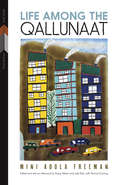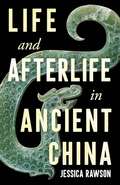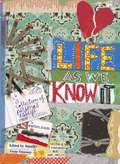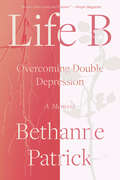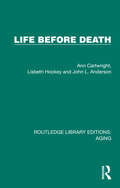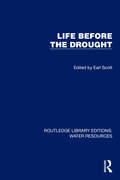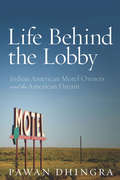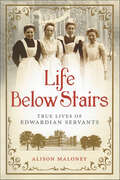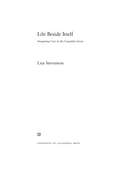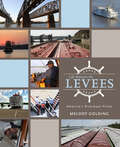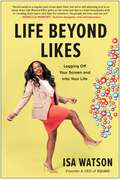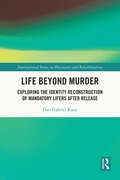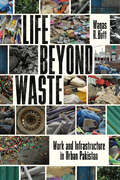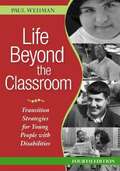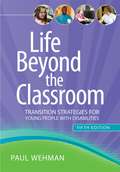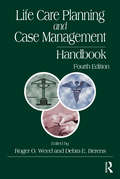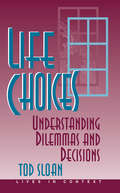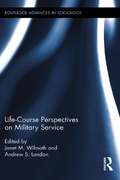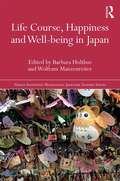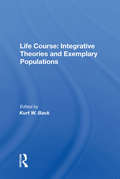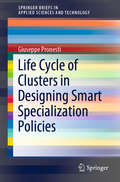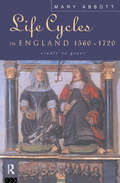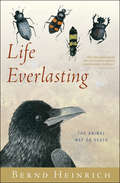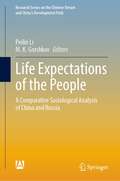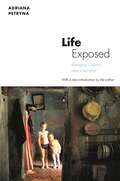- Table View
- List View
Life Among the Qallunaat (First Voices, First Texts #3)
by Julie Rak Mini Aodla Freeman Keavy Martin Norma DunningLife Among the Qallunaat is the story of Mini Aodla Freeman’s experiences growing up in the Inuit communities of James Bay and her journey in the 1950s from her home to the strange land and stranger customs of the Qallunaat, those living south of the Arctic. Her extraordinary story, sometimes humourous and sometimes heartbreaking, illustrates an Inuit woman’s movement between worlds and ways of understanding. It also provides a clear-eyed record of the changes that swept through Inuit communities in the 1940s and 1950s. Mini Aodla Freeman was born in 1936 on Cape Hope Island in James Bay. At the age of sixteen, she began nurse's training at Ste. Therese School in Fort George, Quebec, and in 1957 she moved to Ottawa to work as a translator for the then Department of Northern Affairs and Natural Resources. Her memoir, Life Among the Qallunaat, was published in 1978 and has been translated into French, German, and Greenlandic. Life Among the Qallunaat is the third book in the First Voices, First Texts series, which publishes lost or under appreciated texts by Indigenous writers. This reissue of Mini Aodla Freeman’s path-breaking work includes new material, an interview with the author, and an afterword by Keavy Martin and Julie Rak, with Norma Dunning.
Life And Afterlife In Ancient China
by Jessica RawsonThe three millennia up to the establishment of the first imperial Qin dynasty in 221 BC cemented many of the distinctive elements of Chinese civilization still in place today: an extraordinarily challenging geography and environment; formidable infrastructure; a society based on the strict hierarchy of the family; a shared written script of characters; a cuisine founded on rice and millet; a material culture of ceramics, bronze, silk, and jade; and a unique concept of the universe, in which ancestors continue to exist alongside the living. Records of these early achievements and their diverse expressions often lie not in written history but in how people marked the end of their lives: their dwellings for the afterlife. Tombs and the treasures within them are almost the only artifacts to survive from Ancient China; their scale and sophistication rivals their equivalents in Ancient Egypt. Jessica Rawson, one of the most eminent Western scholars of China, explores twelve grand tombs―each from a specific historical moment and place―showing how they reveal wider political, dynastic, and cultural developments, culminating in the lavish ambition of the First Emperor's monument, guarded by his army of terracotta warriors. Beautifully illustrated and drawing on the latest archaeological discoveries, Life and Afterlife in Ancient China illuminates a constellation of beliefs about life and death and provides a remarkable new perspective on one of the oldest civilizations in the world.
Life As We Know It
by Jennifer Foote Sweeney"...these essays are jewels of the unexpected, and in introducing them, I don't want to steal any of their surprise. Suffice it to say that family life...is alive and well, but it is not like anything you ever read about before in your life." -- Jane Smiley, from the foreword The nuclear family peaked in 1960 with 45 percent of the American population. Many decades later, the tidy ensemble is rare. Relationships, baby making, sex, dating, divorce -- they aren't what they used to be. But the mainstream media keeps the reality of American life a secret, only leaking the occasional tidbit to remind us that those in "unconventional" configurations are a sad anomaly to be pitied or ignored. Life As We Know It offers proof in its most engaging form -- the personal essay -- that the big guys have got it wrong. This collection of blunt, lyrical, and often very funny work from award-winning Salon.com tells the true stories about how we live -- of hustling fertility drugs, losing a child, hating dad, and coming to terms with a parent who was the voice of "Frosty the Snowman" on TV. First-time writers and critically acclaimed authors like Amy Bloom, Kathryn Harrison, Susan Straight, and Benjamin Cheever, plumb the familiar to deliver portraits of moments, seasons, and eras that we recognize or long to understand.
Life B: Overcoming Double Depression
by Bethanne PatrickA bracing and fresh look at a lifelong struggle with depression and mental illnessPlagued by depression her entire life, it wasn&’t until her early fifties that writer and book critic Bethanne Patrick, advocating for her own care, received a medical diagnosis that would set her on the path to wellness and stability.Recognizing the intergenerational effects of trauma and mental health struggles, Patrick unearths the stories of her past in order to forge a better future for herself and her two daughters, dismantling the stigmas surrounding mental health challenges that can plague families into silence and resignation. Life B is an intimate portrait we haven&’t yet seen—of a lifelong struggle with depression, of midlife diagnosis and newly found strength. Most important, it&’s a life-affirming blueprint of how to accept and transcend the limitations of mental illness.
Life Before Death (Routledge Library Editions: Aging)
by Ann Cartwright John L. Anderson Lisbeth HockeySince death is an experience which will inevitably be common to us all, we are often surprisingly uninterested in what services are provided for those people, often the elderly and infirm, who are at risk or who are on the point of death. Originally published in 1973, this study describes the last twelve months in the lives of 785 adults. Based mainly on the reports of close relatives, it is concerned with the needs of the dying and the care they receive. This includes the more emotional aspects such as ‘awareness’ of dying and the effects of the death on relatives. The book looks at the part played by hospitals, general practitioners, local authority health and welfare services, and by relatives, friends and neighbours. The views of those who provide these services are also considered. The picture that emerges shows up the gaps in the care that was given to people in the final year of their lives at the time.
Life Before the Drought (Routledge Library Editions: Water Resources)
by Earl ScottLittle attention had been paid to the realities of life in the Savanna-Sahel of West Africa before the drought of 1968-74, but this book, originally published in 1984 provides a set of authoritative accounts of the way in which the inhabitants cope with what outsiders perceive as a harsh environment. The peoples of the Savanna-Sahel are shown to be developers of strategies and technologies to manage their resources. Their understanding of the environment enables them to contribute substantially to any plans for economic and ecological recovery in the region. Their cooperative modes of life lead to greater social complexity and capacity for survival. Geographers, anthropologists and social historians should find the interdisciplinary human ecological approach of the book appealing. Development economists and rural planners will find the chapters on land-use patterns, and resource use particularly valuable.
Life Behind the Lobby: Indian American Motel Owners and the American Dream
by Pawan DhingraIndian Americans own about half of all the motels in the United States. Even more remarkable, most of these motel owners come from the same region in India and-although they are not all related-seventy percent of them share the surname of Patel. Most of these motel owners arrived in the United States with few resources and, broadly speaking, they are self-employed, self-sufficient immigrants who have become successful-they live the American dream. However, framing this group as embodying the American dream has profound implications. It perpetuates the idea of American exceptionalism-that this nation creates opportunities for newcomers unattainable elsewhere-and also downplays the inequalities of race, gender, culture, and globalization immmigrants continue to face. Despite their dominance in the motel industry, Indian American moteliers are concentrated in lower- and mid-budget markets. Life Behind the Lobbyexplains Indian Americans' simultaneous accomplishments and marginalization and takes a close look at their own role in sustaining that duality.
Life Below Stairs: True Lives of Edwardian Servants
by Alison Maloney&“As a companion to Downton Abbey . . . Maloney&’s study satisfies . . . [a] thorough glimpse into the lives of British house servants in the early 1900s.&” —Shelf Awareness UPSTAIRS, an Edwardian home would have been a picture of elegance and calm, adorned with social gatherings and extravagantly envisioned dinner parties. DOWNSTAIRS, it was a hive of domestic activity, supported by a body of staff painstakingly devoted to ensuring the smooth running of the household. Brimming with family secrets, society scandal, and of course elaborate parties, dresses, and social customs, the world of an aristocratic Edwardian household as depicted on the hit show Downton Abbey has captivated millions. But what was life really like for the people who kept such a household running: the servants? In Life Below Stairs, international bestselling author Alison Maloney takes readers behind the scenes to reveal a lively and colorful picture of what went on &“downstairs,&” describing servants&’ daily life in this now-vanished world. Detailing everything from household structure, pay and conditions, special duties, and rules and regulations, to perks, entertainment, and even romance, Maloney examines the drudgery and hardships below stairs, as well as the rewards and pleasures. Thoroughly researched and reliably informed, this charmingly illustrated volume also contains first-hand stories from the staff of the time, making it a must-read for anyone interested in the lifestyle and conduct of a bygone era. &“This handy compendium is a digestible introduction to the dos and don&’ts of the highly stratified upper-class households of the era. Especially revealing are the interspersed anecdotal snippets culled from the memoirs of both domestic staff members and their well-heeled employers.&” —Booklist
Life Beside Itself
by Lisa StevensonIn Life Beside Itself, Lisa Stevenson takes us on a haunting ethnographic journey through two historical moments when life for the Canadian Inuit has hung in the balance: the tuberculosis epidemic (1940s to the early 1960s) and the subsequent suicide epidemic (1980s to the present). Along the way, Stevenson troubles our commonsense understanding of what life is and what it means to care for the life of another. Through close attention to the images in which we think and dream and through which we understand the world, Stevenson describes a world in which life is beside itself: the name-soul of a teenager who dies in a crash lives again in his friend’s newborn baby, a young girl shares a last smoke with a dead friend in a dream, and the possessed hands of a clock spin uncontrollably over its face. In these contexts, humanitarian policies make little sense because they attempt to save lives by merely keeping a body alive. For the Inuit, and perhaps for all of us, life is "somewhere else," and the task is to articulate forms of care for others that are adequate to that truth.
Life Between the Levees: America’s Riverboat Pilots
by Melody GoldingWinner of the Donald T. Wright Award from the the Herman T. Pott National Inland Waterways Library, a special collection of the St. Louis Mercantile LibraryLife Between the Levees is a chronicle of first-person reflections and folklore from pilots who have dedicated their lives to the river. The stories are as diverse as the storytellers themselves, and the volume is full of drama, suspense, and a way of life a “landlubber” could never imagine. Although waterways and ports in the Mississippi corridor move billions of dollars of products throughout the US and foreign markets, in today's world those who live and work on land have little knowledge of the river and the people who work there. In ten years of interviewing, Melody Golding collected over one hundred personal narratives from men and women who worked and lived on “brown water,” our inland waterways. As photographer, she has taken thousands of photos, of which 130 are included, of the people and boats, and the rivers where they spend their time. The book spans generations of river life—the oldest pilot was born in 1917 and the youngest in 1987—and includes stories from the 1920s to today. The stories begin with the pilots who were “broke in” by early steamboat pilots who were on the river as far back as the late 1800s. The early pilots in this book witnessed the transition from steamboat to diesel boat, while the youngest grew up in the era of GPS and twenty-first-century technology. Among many topics, the pilots reflect movingly on the time spent away from home because of their career, a universal reality for all mariners. As many pilots say when they talk about the river, “I hate her when I’m with her, and I miss her when I’m gone.”
Life Beyond Likes: Logging Off Your Screen and Into Your Life
by Isa WatsonWith so much of our lives lived online, we&’ve never been more connected—or disconnected from what&’s most important to us. It&’s time to let go of our curated online worlds and get beyond our need for likes. For all that we think we&’re getting out of social media, we&’re also getting duped. The perfection echo chamber oftentimes makes us feel like we&’re getting left behind. The truth is, life is messy, but curated online fabulousness makes it hard to let our true selves show, and it impedes our ability to have real, meaningful connections. Depression, anxiety, and suicide are also on the rise, and the virtual world is partially to blame, affecting our self-worth, our friendships, and the way we choose to navigate our real lives. As the founder and CEO of Squad, an app company built on connectedness, Isa Watson knows firsthand why we need to learn how to be more genuine. The digital world is her lifeblood, but it&’s also been an Achilles&’ heel: She struggled privately with some of the biggest challenges life can throw at you, while online she seemed to be living her best life—earning high-profile accolades, taking fabulous trips, and partying with the likes of many big name celebrities. It took a personal crisis to make her realize that she needed to change. In Life Beyond Likes, she gets real, sharing practical guidance on: Getting over the addiction to likes, and letting your true self shine Recognizing your own damaging habits and developing healthy ones Determining when a friendship has run its course Getting comfortable with discomfort in order to make real connections Drawing from a wealth of experiences including being the youngest published chemist in the world, working as executive in the upper echelons at JPMorgan Chase, and founding her own company, Isa helps readers better understand what constitutes success, identify what&’s really important, and achieve a balance between the curated online world and the enriching, emotionally nourishing world right in front of us.
Life Beyond Murder: Exploring the Identity Reconstruction of Mandatory Lifers After Release (International Series on Desistance and Rehabilitation)
by Dan Gabriel RusuDetailing the resettlement narratives of five men who have committed different types of murder (confrontational/revenge, financial gain, random, intimate partner femicide, and family feud), this book counters narratives of neoliberal, ‘responsibilizing’ messages of individualism to investigate what informs their experiences of resettlement.Life Beyond Murder: Exploring the Identity Reconstruction of Mandatory Lifers After Release explores the impact of mandatory lifers’ institutionalisation, families, consumer culture, emotions, and supervision, considering how these factors hamper or assist with their transition from the stigmatising identity of being ‘dangerous murderers’. The book’s discussion is guided by the men’s narratives, employing a ‘tug of war’ metaphor to elucidate the ‘push-pull forces’ that influence the men’s efforts to reconstruct their lives in the years following their release.To be successful, the book argues, these men have to reconcile a paradoxical situation, and the most skilled mandatory lifers manage to relativise their involvement in murder whilst concomitantly showing remorse. This situation is achieved through a Splitting Narrative that ultimately defends against anxiety, contains internal stigma, and often showcases self-flagellant remorse, as they move towards positive social identities such as philanthropists, family men, wounded healers, and pious members of the church.
Life Beyond Waste: Work and Infrastructure in Urban Pakistan (South Asia in Motion)
by Waqas ButtOver the last several decades, life in Lahore has been undergoing profound transformations, from rapid and uneven urbanization to expanding state institutions and informal economies. What do these transformations look like if viewed from the lens of waste materials and the lives of those who toil with them? In Lahore, like in many parts of Pakistan and South Asia, waste workers—whether municipal employees or informal laborers—are drawn from low- or noncaste (Dalit) groups and dispose the collective refuse of the city's 11 million inhabitants. Bringing workers into contact with potentially polluting materials reinforces their stigmatization and marginalization, and yet, their work allows life to go on across Lahore and beyond. This historical and ethnographic account examines how waste work has been central to organizing and transforming the city of Lahore—its landscape, infrastructures, and life—across historical moments, from the colonial period to the present. Building upon conversations about changing configurations of work and labor under capitalism, and utilizing a theoretical framework of reproduction, Waqas H. Butt traces how forms of life in Punjab, organized around caste-based relations, have become embedded in infrastructures across Pakistan, making them crucial to numerous processes unfolding at distinct scales. Life Beyond Waste maintains that processes reproducing life in a city like Lahore must be critically assessed along the lines of caste, class, and religion, which have been constitutive features of urbanization across South Asia.
Life Beyond the Classroom: Transition Strategies for Young People with Disabilities
by Paul WehmanThis classic text, adopted by educators in special and vocational education programs across the country, provides a framework for defining and planning transition, addresses facilitation and support, and discusses ways to individualize transition service delivery for people with specific types of disabilities. Instructors in special and vocational education, and rehabilitation programs love how this text blends theory with practical forms, sample individualized transition plans, and helpful study questions. Photocopiable charts and checklists make it great for the field, as well, so their students will benefit from this text beyond the classroom. The fourth edition is updated with new material on self-determination, inclusion (in schools and the community), high stakes accountability, assistive technology, job carving, social security benefits issues, and application for youth with autism spectrum disorders.
Life Beyond the Classroom: Transition Strategies for Young People with Disabilities (Fifth Edition)
by Paul WehmanFor more than two decades, the trusted Life Beyond the Classroom text has shaped the practices of thousands of professionals helping students make a smooth transition from school to adulthood. Now this landmark textbook is in a NEW fifth edition—updated with the cutting-edge information professionals need in today's changing world, as young people with disabilities face unprecedented financial, family, employment, and educational challenges. A definitive compendium of up-to-date, evidence-based transition research, this expanded new edition takes Life Beyond the Classroom to the next level. Future professionals will get all the latest best practices and timely research on the full spectrum of transition topics, from assessment and assistive technology to social skills and self-determination. With this comprehensive revision of a pioneering text, the next generation of professionals will be fully prepared to give young people with disabilities appropriate, effective, and individualized support as they navigate our increasingly complex society. WHAT'S NEW: New chapters on critical topics: working with families multicultural transition planning teaching social skills secondary curriculum options
Life Care Planning and Case Management Handbook
by Roger O. Weed Debra E. BerensLife care planning is an advanced collaborative case management specialty practice focused on assessing, evaluating, coordinating, consulting, planning for, and monitoring necessary services for individuals with complex medical care needs over their lifetime. This handbook provides a comprehensive resource for all people involved with catastrophic impairments and chronic medical care case management. The Life Care Planning and Case Management Handbook, Fourth Edition, begins by defining the roles played by each of the key team members working with the life care planner. It provides planners with insights critical to successful interactions with medical and health care–related professionals as well as the team members they are most likely to encounter as they work to build an accurate and reliable life care plan. Next, the text offers up-to-date information on the medical conditions most frequently encountered by the life care planner. The contributors, who are recognized experts in their disciplines, also address issues in forensic settings, ethics, standards, research, and credentials. The fourth edition includes numerous chapters on general issues, as well as updated standards of practice from the International Academy of Life Care Planners (IALCP), Life Care Planning Consensus Statements, and valuable step-by-step charts and checklists. Completely updated and expanded, this revised handbook now includes new chapters on multicultural considerations in life care planning, admissibility of life care plans in U.S. courts, and Canadian life care planning practice. Additionally, infused in other chapters, is new information on medical coding and costing for life care planners, life care planning in non-litigated contexts, as well as research and education within life care planning.
Life Choices: Understanding Dilemmas and Decisions (Lives in Context)
by Tod Sloan<p>This book may be viewed as an “antiguide” to decisionmaking. It rejects mechanical formulas and urges self-reflection and a critique of ideology. Through close readings of fifteen life history interviews, Tod Sloan creates a framework for the interpretation of dilemmas and decisions. Ultimately, we see that a life choice or turning point comprises three phases—dilemma, deliberation, and decision. As each individual recounts a specific instance when a life choice was necessary, the supporting analysis reveals the framework that triggered the sense that a turning point had been reached. <p>Sloan's basic premise is that common sense and mainstream psychology fail to enlighten us about what is actually involved in major life choices. Individuals tend to make decisions that are not in their best interests and, in fact, these decisions tend to reinforce the sociocultural structures that were initially instrumental in the creation of their dilemmas. By reading the extensive case histories and examining the ways in which the subjects' cultural and social embeddedness interacts with unconscious processes, the reader can develop the ability to understand and think critically about personal life decisions.Developed as an antidote to traditional self-help books, Sloan's decision analysis framework is derived from cognitive, phenomenological, and psychoanalytic theory. Each aspect of the decisionmaking process—from the emergence of a dilemma to postdecision regret—can be understood by considering the contexts of personality, life history, practical arrangements, and ideology.</p>
Life Course Perspectives on Military Service: Life Course Perspectives On Military Service (Routledge Advances in Sociology #83)
by Janet M. Wilmoth Andrew S. LondonThis edited volume provides a comprehensive and critical review of what we know about military service and the life course, what we don’t know, and what we need to do to better understand the role of military service in shaping people's lives. It demonstrates that the military, like colleges and prisons, is a key social institution that engages individuals in early adulthood and shapes processes of cumulative (dis)advantage over the life course. The chapters provide topical synthesizes of the vast but diffuse research literatures on military service and the life course, while the volume as a whole helps to set the agenda for the next generation of data collection and scholarship. Chapter authors pay particular attention to how the military has changed over time; how experiences of military service vary across cohorts and persons with different characteristics; how military service affects the lives of service members’ spouses, children, and families; and the linkages between research and policy.
Life Course, Happiness and Well-being in Japan
by Barbara Holthus Wolfram ManzenreiterMuch of the existing literature on happiness in Japan has been produced in the field of economics and psychology and is quantitative in nature. Here, for the first time, a group of anthropologists and sociologists jointly analyze the state of happiness and unhappiness in Japan among varying social groups in its physical, interpersonal, existential and structural dimensions, offering new insights into fundamental issues. This book investigates the connections between sociostructural aspects, individual agency and happiness in contemporary Japan from a life course perspective. The contributors examine quantitative and qualitative empirical data on the processes that impact how happiness and well-being are envisioned, crafted, and debated in Japan across the life-cycle. Therefore, the book discusses the shifting notions of happiness during people’s lives from birth to death, analyzing the age group-specific experiences while taking into consideration people’s life trajectories and historical changes. It points out recent developments in regards to demographic change, late marriage, and the changing labor market and focuses on their significant impact on the well-being of Japanese people. In particular it highlights the interdependencies of lives within the family and how families are collaborating for the purpose of maintaining or enhancing the happiness of its members. Broadening our understanding of the multidimensionality of happiness in Japan, this book will be of interest to students and scholars of Japanese Studies, Anthropology, and Sociology.
Life Course: Integrative Theories And Exemplary Populations
by Kurt W. BackIn this interdisciplinary study of the human life course as a unit, scholars examine aspects of the life course, looking at several features over a short span and at a few traits over a longer period. provides an overview from disciplines (e.g., history, demography, sociology) that are concerned with understanding the human life course; contains studies of special populations in which integration of a variety of experiences over time can be accomplished. Based on these approaches, new methods appropriate to a science of human life are proposed and discussed in a form suitable for students, faculty, and professionals in human development (sociology, anthropology, psychology), demography, and gerontology.
Life Cycle of Clusters in Designing Smart Specialization Policies (SpringerBriefs in Applied Sciences and Technology)
by Giuseppe PronestìThis book investigates cluster-life-cycle (CLC) analysis to inform the entrepreneurial discovery process (EDP), in order to support the effectiveness of the smart specialization strategy (S3). It focuses on the evolutionary analysis of clusters’ development stages (emergence, development, maturity, decline/transformation), highlighting how different phases of the CLC have a different role in informing S3-policy-making and identifying regions’ potentials to specialize. In so doing, it offers an original conceptual model that explains what information can be provided by CLC analysis in the effective design and implementation of S3 and EDP, systematizes clusters' stage-specific features, and unveils the role played by each CLC stage. It contributes to the emerging academic debate on the role of the CLC concept in policy-making, by highlighting the importance of CLC analysis in dynamically investigating regional contexts and tailoring development policies such as S3. The book is an invaluable resource for academics and regional policy makers, providing them with guidance and recommendations on how to effectively approach the design and implementation of S3 and EDP, by fully tapping the potential of CLC analysis.
Life Cycles in England 1560-1720: Cradle to Grave
by Mary AbbottThis book plots the human career in England, between 1560 and 1720, from birth to old age. It provides a collection of extracts from texts written in the period as well as collection of photographs of images and artefacts made in England between the period.
Life Everlasting: The Animal Way of Death
by Bernd HeinrichAn enlightening look at animal behavior and the cycle of life and death, from &“one of the finest naturalists of our time&” (Edward O. Wilson). When a good friend with a severe illness wrote, asking if he might have his &“green burial&” at Bernd Heinrich&’s hunting camp in Maine, it inspired the acclaimed biologist to investigate a subject that had long fascinated him. How exactly does the animal world deal with the flip side of the life cycle? And what are the lessons, ecological to spiritual, imparted by a close look at how the animal world renews itself? Heinrich focuses his wholly original gaze on the fascinating doings of creatures most of us would otherwise turn away from—field mouse burials conducted by carrion beetles; the communication strategies of ravens, &“the premier northern undertakers&”; and the &“inadvertent teamwork&” among wolves and large cats, foxes and weasels, bald eagles and nuthatches in cold-weather dispersal of prey. Heinrich reveals, too, how and where humans still play our ancient and important role as scavengers, thereby turning not dust to dust, but life to life. &“If it has not been clear to readers by now, this book confirms that Bernd Heinrich is one of the finest naturalists of our time. Life Everlasting shines with the authenticity and originality that are unique to a life devoted to natural history in the field.&” —Edward O. Wilson, author of The Meaning of Human Existence and The Social Conquest of Earth
Life Expectations of the People: A Comparative Sociological Analysis of China and Russia (Research Series on the Chinese Dream and China’s Development Path)
by Peilin Li M. K. GorshkovThis book compares the Chinese and Russian dreams, focusing on eight aspects: prosperity, affluence, family harmony, fairness and justice, diversity, green beauty, honesty and uprightness, and happiness. Based on large-scale survey data combined with the corresponding sociological theory for analysis, it presents detailed information, compelling arguments, and well-founded conclusions, offering insights into the commonalities and differences between these two countries' dreams.
Life Exposed: Biological Citizens after Chernobyl (In-formation Ser.)
by Adriana PetrynaOn April 26, 1986, Unit Four of the Chernobyl nuclear reactor exploded in then Soviet Ukraine. More than 3.5 million people in Ukraine alone, not to mention many citizens of surrounding countries, are still suffering the effects. Life Exposed is the first book to comprehensively examine the vexed political, scientific, and social circumstances that followed the disaster. Tracing the story from an initial lack of disclosure to post-Soviet democratizing attempts to compensate sufferers, Adriana Petryna uses anthropological tools to take us into a world whose social realities are far more immediate and stark than those described by policymakers and scientists. She asks: What happens to politics when state officials fail to inform their fellow citizens of real threats to life? What are the moral and political consequences of remedies available in the wake of technological disasters? Through extensive research in state institutions, clinics, laboratories, and with affected families and workers of the so-called Zone, Petryna illustrates how the event and its aftermath have not only shaped the course of an independent nation but have made health a negotiated realm of entitlement. She tracks the emergence of a "biological citizenship" in which assaults on health become the coinage through which sufferers stake claims for biomedical resources, social equity, and human rights. Life Exposed provides an anthropological framework for understanding the politics of emergent democracies, the nature of citizenship claims, and everyday forms of survival as they are interwoven with the profound changes that accompanied the collapse of the Soviet Union.
